Your rubber plant's leaf drop is likely due to one of five common stressors. If you've noticed falling leaves, check for improper light exposure, incorrect watering patterns, sudden temperature changes, low humidity levels, or pest infestations. Each of these factors can trigger leaf loss in different ways, from gradual dropping to sudden shedding. Understanding these key triggers and their warning signs will help you restore your plant's health.
Understanding Light Stress and Leaf Drop
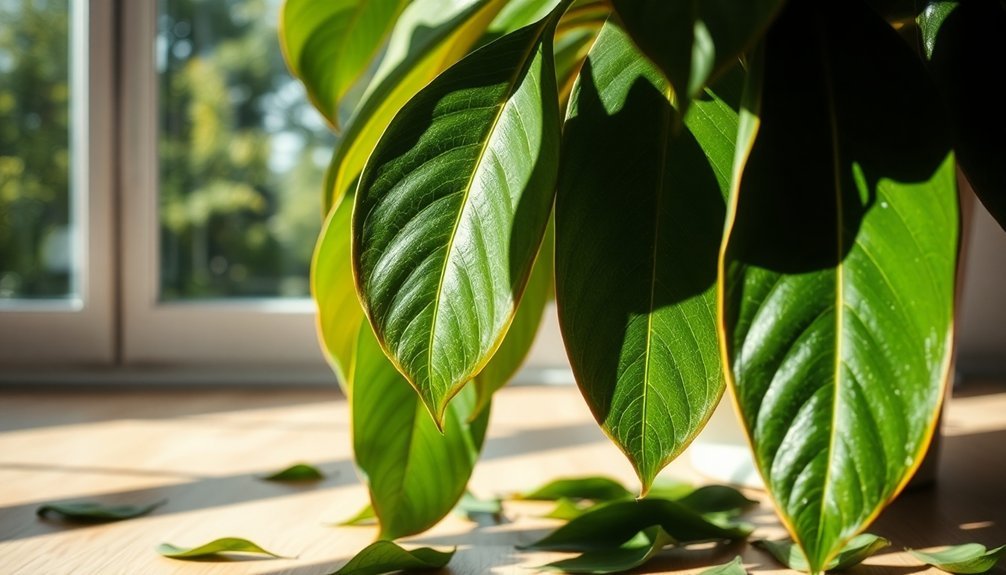
When your rubber plant starts dropping leaves, inadequate lighting is often the culprit. Your plant needs several hours of bright, indirect light daily to maintain healthy growth, and without it, you'll notice leggy stems and dropping lower leaves.
Proper lighting is vital for rubber plants – without enough bright, indirect sunlight, they'll respond with leaf drop and leggy growth.
If you've recently relocated your rubber plant, the sudden change in light conditions could be causing stress. This is especially common when shifting from summer to fall, as natural light levels decrease.
To prevent leaf loss, you'll want to gradually acclimatize your plant to its new environment. The best placement for your rubber plant is near north or east-facing windows, where it'll receive sufficient indirect light without the risk of leaf damage.
During darker months, consider adding grow lights to maintain consistent light levels and prevent seasonal leaf drop.
Water Management and Root Health
You'll need to watch for key signs of root rot in your rubber plant, including yellowing leaves that drop easily and dark, mushy roots that smell unpleasant.
To prevent root issues, establish a watering routine based on your plant's soil moisture level rather than following a rigid schedule, making certain the top few inches are dry before watering again.
If you notice drooping leaves turning crispy and brown, your plant is likely underwatered and requires a thorough soaking, preferably from the bottom up to guarantee even moisture distribution.
Signs of Root Rot
Root rot presents three unmistakable warning signs in rubber plants: yellowing leaves, mushy roots with a foul odor, and stunted growth.
If your rubber plant is losing leaves while showing these symptoms, you're likely dealing with root rot caused by overwatering.
To confirm root rot, carefully remove your plant from its pot and examine the roots. Healthy roots should be firm and white, while diseased roots will be brown, soft, and emit an unpleasant smell.
When you spot these signs, don't wait to take action. Using sterilized scissors, trim away all affected roots, then repot your plant in fresh, well-draining soil.
To prevent future problems, allow the top few inches of soil to dry between waterings and ascertain your pot has proper drainage holes.
Proper Watering Schedule
Because rubber plants thrive on consistent moisture, establishing a proper watering schedule is essential for their root health.
If your rubber plant is losing leaves, improper watering could be the culprit. Don't rely on a fixed schedule of one cup every two weeks; instead, check the soil moisture 3-4 inches deep before watering.
When you water, do it thoroughly until water drains from the bottom of the pot, ensuring the roots receive adequate hydration.
Let the top few inches of soil dry between waterings to prevent waterlogged conditions. If you notice droopy or yellowing leaves, assess your watering habits immediately.
For severely dry plants, try bottom watering to rehydrate the root ball evenly. This method helps restore moisture throughout the soil while preventing both over and under-watering issues.
Temperature Fluctuations and Cold Drafts
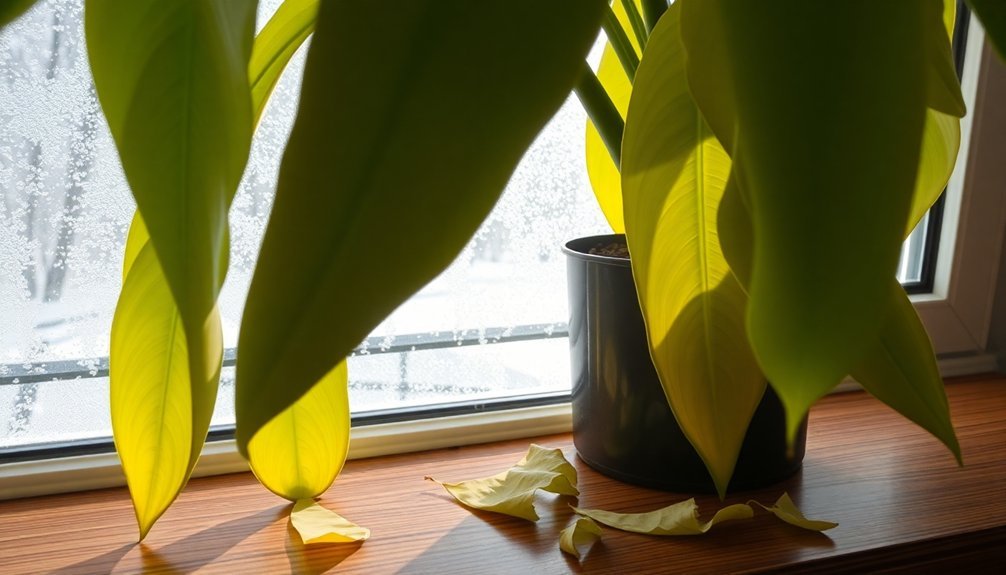
While rubber plants can tolerate a range of indoor temperatures, sudden changes and cold drafts can trigger significant leaf loss. Your plant may struggle to adapt when exposed to temperature fluctuations, causing it to drop leaves as a stress response.
This is particularly true during winter months when drafty windows, doors, or air vents create cold spots in your home. Even if you maintain an ideal room temperature overall, your rubber plant can still suffer if it's positioned near sources of cold air.
To protect your plant, keep it away from drafty areas and make certain it experiences consistent temperatures throughout the day. Consider moving it to a more stable environment, away from windows and doors, where it won't be subjected to sudden temperature changes that could shock its system.
Humidity Levels and Environmental Balance
In addition to stable temperatures, proper humidity plays a key role in preventing rubber plant leaf loss. Your rubber plant needs humidity levels between 40% to 60% to maintain healthy, vibrant foliage.
When the air becomes too dry, especially during winter months, you'll notice your plant's leaves turning yellow or brown before dropping.
You can easily maintain ideal humidity levels by misting your plant daily or setting up a humidity tray filled with pebbles and water beneath the pot. This simple solution creates a moisture-rich microclimate around your plant.
Not only does proper humidity prevent leaf drop, but it also strengthens your rubber plant's natural defenses against pests and diseases.
If you're noticing consistent leaf loss, check your home's humidity levels first, as dry air is often the culprit.
Common Pest Infestations and Solutions
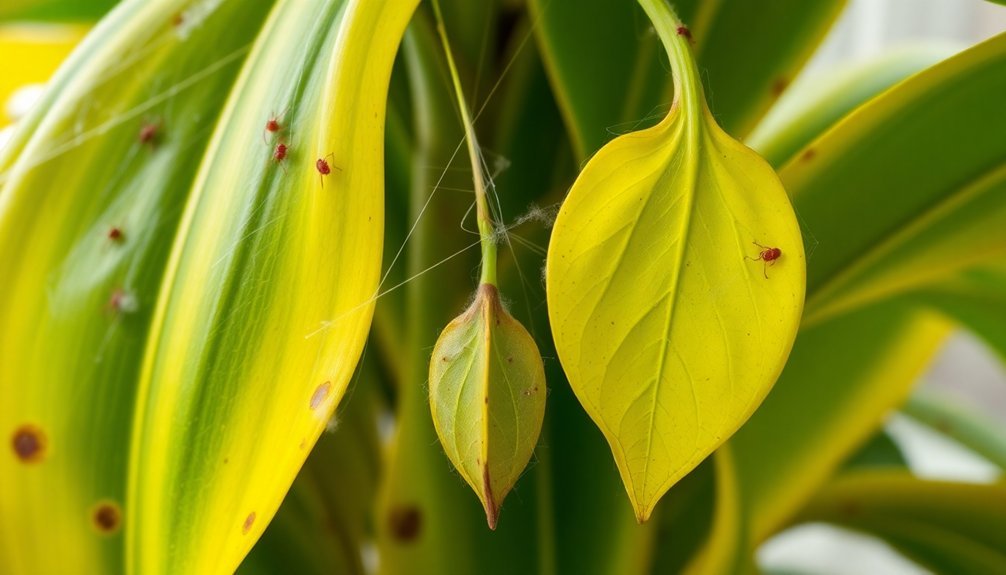
Pests can wreak havoc on your rubber plant, causing unsightly leaf damage and eventual leaf drop. You'll need to regularly check the undersides of leaves and stems for common pest infestations like spider mites, scale, aphids, and mealybugs. Early detection is essential for preventing severe damage to your plant.
| Pest Type | Signs | Treatment |
|---|---|---|
| Spider Mites | Fine webbing, tiny spots | Neem oil |
| Scale | Brown bumps on stems | Rubbing alcohol |
| Aphids | Sticky residue, clusters | Insecticidal soap |
| Mealybugs | White cotton-like patches | Rubbing alcohol |
If you discover pests, immediately quarantine your affected rubber plant from other houseplants. Apply your chosen treatment method consistently until the infestation clears. Remember, maintaining a healthy plant through proper care makes it naturally more resistant to pest infestations.
Soil Quality and Drainage Issues
Poor soil conditions can devastate your rubber plant's health, leading to leaf loss and stunted growth. When you're dealing with soil quality issues, proper drainage becomes your first line of defense against root problems.
Neglecting soil health can spell disaster for rubber plants. Quality drainage protects roots and prevents the cascade of problems that follow poor conditions.
Your rubber plant needs a well-balanced mix of potting soil, perlite, and peat moss to thrive.
Here's what you need to watch for:
- Check your pot's drainage holes regularly to prevent blockages
- Look for signs of soil compaction, which restricts root growth
- Monitor the soil's moisture retention – if water sits too long, it's time to adjust your mix
Don't wait until your plant shows distress – repot every 1-2 years with fresh soil to maintain ideal growing conditions.
This simple maintenance routine will help prevent leaf drop and guarantee your rubber plant maintains its lush appearance.
Seasonal Changes and Plant Adaptation
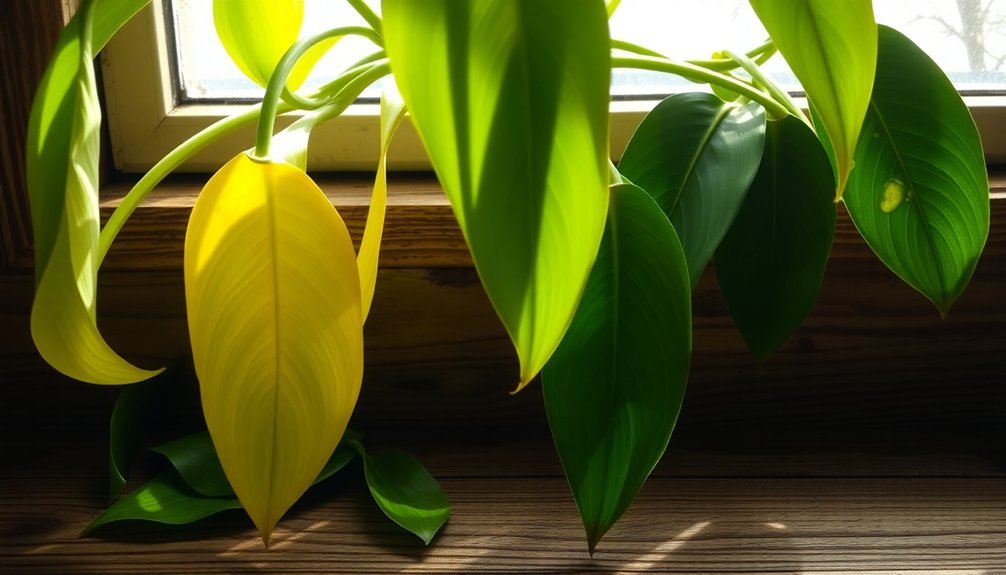
Your rubber plant's leaf loss might be a natural response to seasonal shifts, as shorter daylight hours and decreased light intensity trigger the plant to shed leaves and conserve energy.
During fall and winter changes, you'll notice your plant adapting to temperature changes, which can stress the plant if the indoor environment fluctuates too dramatically.
While your rubber plant enters a period of relative dormancy during these seasonal alterations, you can help it adjust by maintaining consistent indoor conditions and gradually adapting it to areas with better light exposure.
Light Intensity Changes Seasonally
As seasons change throughout the year, rubber plants must adapt to varying levels of natural light, which can greatly impact their health and leaf retention.
You'll notice that light levels decrease considerably during the shift from summer to fall, potentially causing stress and leaf drop in your plant if it's not properly acclimated.
To help your rubber plant thrive through seasonal changes:
- Gradually move your plant to its new location to prevent shock from sudden light intensity changes
- Consider using plant lights during darker seasons to maintain consistent light exposure
- Place your plant in a bright, indirect light location to prevent leggy growth and excessive leaf loss
Temperature Shifts Impact Growth
Beyond changes in light exposure, temperature fluctuations play a significant role in your rubber plant's health and growth patterns.
When you move your plant between warm indoor spaces and areas with cold drafts, you're risking leaf drop due to temperature shock.
You'll notice this issue becoming more prominent during seasonal changes, particularly as summer shifts to fall. Your rubber plant is sensitive to these temperature shifts, and maintaining stability is key to preventing stress-induced leaf loss.
If you've placed your plant near windows, doors, or air conditioning vents, you're exposing it to harmful cold drafts that can trigger leaf drop even if your room temperature seems appropriate.
To protect your rubber plant, keep it away from areas prone to temperature fluctuations and guarantee it enjoys a consistent environment year-round.
Dormancy Period Requirements
During fall and winter months, rubber plants enter a natural dormancy period that triggers specific changes in their growth patterns.
If your rubber plant is losing leaves during this time, don't panic – it's adapting to seasonal changes by conserving energy and resources.
To support your plant through dormancy, follow these essential care adjustments:
- Reduce watering frequency and fertilizer applications, as your plant's growth notably slows.
- Maintain consistent room temperature and humidity levels to minimize stress.
- Allow gradual light changes when moving your plant to accommodate seasonal changes.
Remember that leaf drop is a natural response to dormancy, particularly affecting older leaves.
Relocation Shock and Recovery
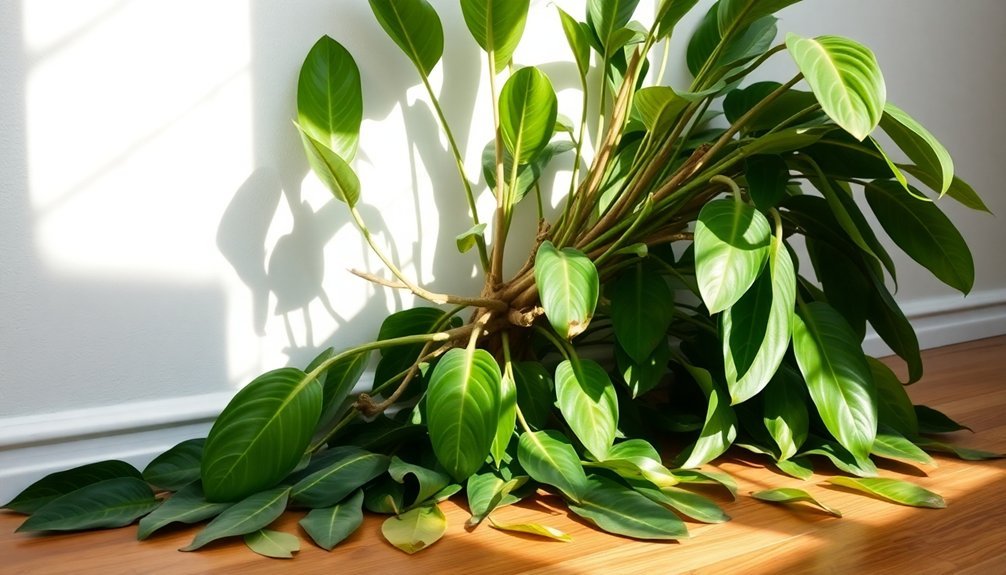
When your rubber plant suddenly drops leaves after being moved to a new spot, it's likely experiencing relocation shock. This stress response occurs as your plant struggles to adapt to its new environment's different light and humidity conditions.
To help your rubber plant recover, you'll want to minimize the shock by making gradual adjustments rather than sudden moves. If you're relocating from a bright area to a dimmer one, your plant will need time to adjust to the reduced light exposure.
Keep a close eye on your watering routine, as the plant's moisture needs might change in its new location. Don't worry if recovery seems slow – your plant needs time to stabilize before producing new growth.
With consistent care and patience, your rubber plant will eventually adapt to its new home.
Signs of Over-Fertilization
Much like relocation stress, improper fertilization can trigger leaf loss in rubber plants. Over-fertilization is a common mistake that can severely damage your plant's health, causing nutrient burn and root problems.
You'll notice several warning signs when you've given your rubber plant too many nutrients.
- Yellowing leaves with crispy edges indicate nutrient burn, a clear sign that you're overfeeding your plant.
- Sudden leaf drop occurs as your plant tries to cope with the stress of excessive nutrients.
- Stunted growth suggests root damage from nutrient overload, which prevents proper water and nutrient absorption.
To protect your rubber plant, feed it sparingly during the growing season only, spacing fertilizer applications 4-6 weeks apart.
When you do fertilize, dilute the solution and carefully follow the manufacturer's dosage instructions.
Root System Problems and Solutions
A healthy root system forms the foundation of your rubber plant's survival, yet various issues can compromise its importance and trigger leaf loss.
Common root system problems stem from improper watering practices. When you overwater your plant, the roots can develop rot, causing yellowing leaves to fall off. Similarly, if your pot lacks proper drainage, the roots won't get enough oxygen in the waterlogged soil.
Don't overlook underwatering either – it stresses the roots and leads to wilting and leaf drop.
To prevent these issues, check soil moisture by inserting your finger 3-4 inches deep into the soil. If you notice your plant struggling, consider repotting it in fresh soil with adequate drainage. This simple solution can help revive the root system and restore your rubber plant's health.
Air Quality and Ventilation Effects
Since rubber plants thrive in stable environments, proper air quality and ventilation play essential roles in preventing leaf loss. Your plant's health depends on consistent air circulation without exposure to harsh drafts that can shock its system and trigger leaf drop.
To maintain ideal air quality for your rubber plant:
- Position your plant away from windows, doors, and air vents that create cold drafts.
- Confirm good ventilation while protecting the plant from sudden temperature changes.
- Keep the plant in a smoke-free environment, as pollution can cause leaf discoloration.
If you notice your rubber plant losing leaves despite proper watering and lighting, check its location for potential air quality issues.
Remember that while these plants benefit from gentle air circulation, they're sensitive to environmental stress from unstable conditions.
Plant Disease Recognition and Treatment
Early recognition of plant diseases is essential for saving your rubber plant from severe leaf loss. If you notice yellowing leaves, black spots, or wilting, your rubber plant is losing leaves due to potential fungal infections, bacterial leaf spot, or root rot.
A mushy or foul-smelling root system is a clear warning sign that requires immediate action.
To effectively treat these diseases, you'll need to apply neem oil or appropriate fungicides according to package instructions.
Combat rubber plant diseases effectively by applying neem oil or suitable fungicides, always following the product's recommended application guidelines.
Don't forget to check your plant's leaves regularly for unusual textures or discoloration to catch problems early.
Prevention is key – maintain proper air circulation around your plant and follow correct watering practices to minimize disease risks.
These steps will help guarantee your rubber plant stays healthy and maintains its foliage.
Growth Pattern Assessment and Care
Understanding your rubber plant's growth patterns helps you identify and address leaf loss before it becomes severe. Your plant's growth habits and leaf retention are directly tied to its environmental conditions, making it essential to maintain ideal growing conditions.
To guarantee healthy growth and prevent leaf drop in rubber plants:
- Position your plant near north or east-facing windows for bright, indirect light, preventing leggy growth and leaf loss.
- Monitor soil moisture by checking the top few inches, watering only when dry to avoid overwatering stress.
- Create a stable environment with consistent temperature and higher humidity through misting or pebble trays.
Regular inspection of these growth factors helps you maintain a thriving rubber plant.
Remember to keep it away from drafts and vents, as sudden temperature changes can trigger leaf drop.
Frequently Asked Questions
How Do I Stop Leaves Falling off My Rubber Plant?
Keep your rubber plant in bright indirect light, don't overwater, maintain humidity with misting, avoid sudden location changes, and check for pests. If you follow these steps, you'll prevent leaf drop.
What Does an Overwatered Rubber Plant Look Like?
You'll notice your overwatered rubber plant has yellowing, drooping leaves that feel mushy. The soil will be consistently soggy, and leaves may fall off. Root rot can cause black, decaying roots underneath.
Why Are the Leaves on My Rubber Tree Turning Yellow and Falling Off?
Your rubber tree's leaves are likely turning yellow and falling off due to overwatering, poor light, or low humidity. Check the soil moisture, guarantee bright indirect light, and consider using a humidifier.
How Often Should a Rubber Plant Be Watered?
You'll want to water your rubber plant when the top 2-4 inches of soil feel dry. Don't follow a strict schedule, but typically this means watering every 1-2 weeks depending on your home's conditions.
In Summary
Don't panic if your rubber plant drops leaves – it's often sending you signals about its care needs. Watch for changes in light, water, temperature, and humidity to pinpoint the issue. Check regularly for pests, root problems, and diseases. Once you've identified the cause, adjust your care routine accordingly. With proper attention and environmental balance, you'll see your rubber plant flourish again.

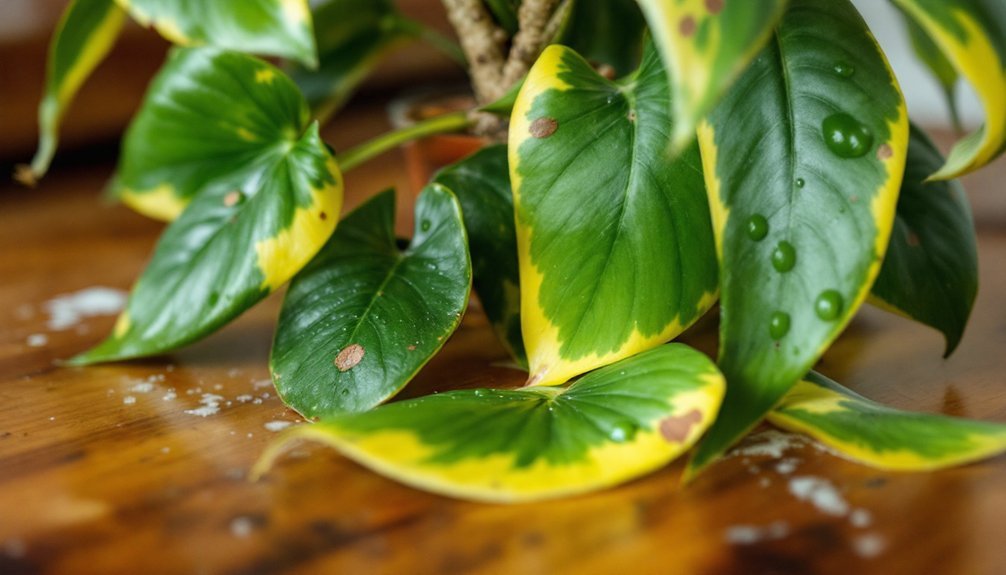



Leave a Reply